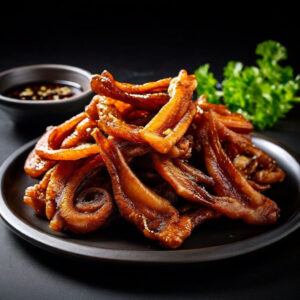Miso is a traditional Japanese seasoning that has recently grown in popularity worldwide. Made from fermented soybeans, rice, or barley, this salty, umami-rich paste can add flavor to many dishes. As more cat owners cook with miso, many wonder – can cats eat miso?
Is this ingredient safe and healthy for feline companions to eat? Or should cat parents avoid feeding miso to their pets?
This article will explore the potential benefits and risks of cats eating miso. We’ll discuss proper serving sizes, health considerations, and alternatives for healthy cat treats. Read on to learn everything you need to know about whether and how much miso cats can eat.
Table of Contents
Can Cats Eat Miso? Is Miso Safe for Cats to Eat?
Miso paste is generally safe for cats to eat in very small quantities. The main ingredients in miso are soybeans, rice or barley, and salt. None of these foods are toxic to cats. However, that doesn’t necessarily mean miso should be a regular part of your cat’s diet. Here are a few considerations on the safety of miso for cats:
- Ingredients – Miso’s core ingredients are not poisonous or toxic to cats. Soybeans even provide a good source of plant-based protein. However, some miso varieties add ingredients like garlic, onion, chiles, or alcohol that can be unsafe.
- Salt content – The main risk of miso is its high sodium levels. Too much sodium is unhealthy for cats, especially those with heart disease or kidney problems. But small, occasional portions of miso are unlikely to cause issues.
- Allergies – Some cats may be allergic or intolerant to ingredients in miso like soy. Make sure your cat has tolerated soy before feeding them miso.
- Digestive upset – Too much miso could potentially cause stomach upset, gas, or diarrhea. But many cats enjoy miso in moderation with no issues. Start slowly.
So in reasonable portions, miso is likely fine for most healthy cats to eat occasionally as a treat. Check the ingredients to avoid onion, garlic or other add-ins. And introduce it slowly to watch for allergies or tummy troubles.
Nutritional Value of Miso for Cats
Miso does have some nutritional value for cats due to its main ingredients:
- Protein – Miso provides plant-based protein from soybeans or other beans. This gives cats amino acids for muscle maintenance.
- Fiber – Fermented soybean miso contains prebiotic fiber to support digestive health.
- Vitamins – Miso provides B vitamins like folate, plus vitamin K. These support metabolism and blood health.
- Minerals – Miso contains minerals like manganese, copper, and zinc. These support immune function and enzyme activity.
However, miso’s sodium content is far higher than ideal for cats. So it should comprise only a very small portion of your cat’s overall diet. Don’t rely on it as a key source of daily nutrition.
Health Benefits of Miso for Cats
Some specific potential health benefits cats may gain from eating small amounts of miso include:
Digestive Support
The probiotics created during miso’s fermentation may benefit cats’ digestion. The fiber in soybean miso may also promote healthy stool formation and regularity.
Antioxidants
Miso made from soybeans contains antioxidant compounds like genistein. Antioxidants can help reduce oxidative damage to cells and may lower inflammation.
Cardiovascular Effects
Small studies show miso may reduce blood pressure and cholesterol in humans. This effect hasn’t been proven in cats but could potentially promote heart health.
However, few scientific studies have specifically analyzed miso’s effects in cats. While it likely provides some nutritional value, miso shouldn’t be considered a medicinal supplement for cats. Consult your vet before feeding miso to try to treat any health condition.
Potential Risks of Feeding Miso to Cats
While small portions of miso are probably safe for most cats, possible risks include:
High Sodium
By far the biggest risk of miso for cats is its high sodium content. 100g of miso can contain up to 4,000mg of sodium. For comparison, the maximum total daily sodium intake for a 10lb cat is only around 20-40mg.
Too much sodium can cause hypertension, heart disease, and fluid buildup in cats with kidney disease or failure.
Allergies and Intolerances
Like humans, some cats are allergic or intolerant to ingredients in miso, especially soy. Diarrhea, vomiting, itching and digestive upset after eating miso could indicate an allergy.
Weight Gain
Miso’s savory flavor may tempt some cats to overeat. Its high calorie and fat content could contribute to obesity if fed in excess.
Gastrointestinal Effects
Eating too much miso could potentially cause flatulence, diarrhea or constipation. Start with small portions and discontinue use if any distress.
Toxic Add-Ins
Some types of miso add ingredients like onions, garlic, alcohol or chiles that are toxic to cats. Check labels and avoid these varieties.
So talk to your vet before feeding miso, especially for cats with any health conditions. Only offer tiny servings infrequently to minimize risks. Monitor your cat closely for any negative reactions.
How Much Miso Can Cats Eat?
Miso is very salty and strong-flavored, so cats only need a small amount to enjoy the taste. Here are some serving guidelines:
- Start with just 1/4 to 1/2 teaspoon of miso at first to gauge your cat’s reaction.
- 1 teaspoon a few times a week is likely safe for most healthy cats. This provides a taste without excess sodium.
- Do not exceed 2 teaspoons total per week, even for large cats. More than this can quickly elevate sodium intake.
- For cats with heart/kidney issues, ask your vet about safe portion sizes or avoid miso altogether.
- Mix miso into food rather than feeding it straight for easier control over intake.
Remember that cat food already provides a balanced diet – miso should only supplement that in tiny amounts as an occasional treat. Never replace proper cat food with miso.
How to Safely Feed Your Cat Miso

Follow these tips for safely adding small amounts of miso to your cat’s diet:
- Check the label: Ensure the miso doesn’t contain garlic, onion, chiles, alcohol or other add-ins toxic to cats. Purchase plain soybean or rice miso varieties.
- Buy from a trustworthy source: Confirm the miso is safe for human consumption to reduce risks in case your cat consumes more than you anticipate.
- Start slowly: Introduce just a tiny amount like 1/4 tsp first. Wait a day or two to ensure no reactions before giving more.
- Mix into food: Stir a bit of miso into your cat’s regular wet or dry food. This helps control portions and prevents overindulging in the tasty seasoning.
- Avoid free feeding: If you free feed dry food, miso intake becomes harder to regulate. Either hold back dry food before giving miso or switch to meal feeding times.
- Supervise your cat: Don’t leave miso unattended with your cat. Keep an eye on exactly how much they consume.
- Monitor for reactions: Watch for vomiting, diarrhea, itching, or other signals of food intolerance/allergies after feeding miso. Discontinue use if any distress.
- Ask your vet: Consult with your veterinarian before feeding miso, especially for cats with medical conditions or dietary needs. Follow their personalized recommendations.
By using proper precautions and portion control, most cats can occasionally enjoy small tastes of miso. But check with your vet if you have any concerns.
Healthier Treat Alternatives for Cats
While the occasional tiny bit of miso is likely fine, you may prefer giving your cat other treats that are healthier and safer options. Some alternatives to try instead of miso include:
Lean Meats
Cats love a taste of protein-rich chicken, turkey, beef, or fish. Opt for low-fat, unseasoned boiled, baked, or roasted meat.
Commercial Cat Treats
Look for low-carb, high-protein treats made with healthy ingredients and minimal additives.
Fruits and Vegetables
Some cats enjoy small pieces of apple, banana, blueberries or carrots. Make sure any produce is cat-safe.
Catnip or Catgrass
These nourishing greens grown specifically for cats provide fiber and entertainment.
Bone Broth
Homemade or commercial low-sodium bone broth offers hydration and nutrients.
Freeze-Dried Raw Food
These minimally processed treats maintain nutrients without preservatives.
No matter which treat you choose, moderation is key. Combine treats with your cat’s balanced main meals instead of replacing them. Avoid treats with added salt, sugars, oils, onions and other unhealthy add-ins. Always check with your vet if introducing any new food.
When Not to Give Your Cat Miso
Certain felines are better off avoiding miso completely. Do not feed miso paste to:
- Cats with known soy, rice/grain, or seasoning allergies
- Cats who have reacted poorly to miso in the past
- Kittens under 1 year old (their digestion is still developing)
- Pregnant or nursing cats (restricting their sodium is safest)
- Cats with hypertension, heart disease, or kidney disease
- Cats with previously elevated sodium levels
- Cats on prescription kidney or heart-healthy diets
- Any cat without first consulting your veterinarian
Cats who fall into these categories are better off sticking to cat foods and treats formulated specifically for their health status. Don’t take risks by feeding questionable human foods without a vet’s guidance.
Ask Your Vet Before Feeding Miso
Given the potential health risks of excess sodium, it’s safest to check with your veterinarian before sharing miso or other human foods with your cat.
Be ready to provide details on:
- Your cat’s current health status, medical conditions, medications or prescription diet
- Any known food allergies or intolerances
- Your cat’s typical diet – i.e., type of food, feeding amount, meal schedule
- The type and amount of miso you hope to feed
Your vet can then advise on:
- Whether miso is appropriate for your individual cat
- A personalized safe serving size limit
- How to gradually introduce miso and monitor for reactions
- Healthier alternatives to try instead of miso
- Precautions based on your cat’s needs
Following your vet’s recommendations helps protect your cat and avoids causing any harm with improper feeding. Don’t take internet advice over your own veterinarian’s counsel.
Conclusion
Miso likely won’t do most cats much good, but small amounts probably won’t hurt either. This salty, savory condiment can provide a tasty treat in strict moderation. But miso’s high sodium content requires caution. Be sure to introduce miso slowly while watching closely for negative reactions. Consult your vet to determine appropriate serving sizes or alternatives for your cat’s needs. With judicious use, miso can provide cats a dash of flavor and nutrition. But it should never become a dietary staple or replace your cat’s regular, balanced food.
Frequently Asked Questions
Is it safe to add miso paste to my cat’s food?
In small amounts, adding a bit of miso to your cat’s regular food should be fine. But limit it to about 1/4 to 1 teaspoon and stir thoroughly to prevent over-consuming. Consult your vet first.
Can kittens eat miso too?
Kittens under 1 year old should avoid miso, as their digestive systems are still developing. Stick to kitten-formulated foods and treats instead.
What if my cat eats too much miso?
Contact your vet if your cat consumes excessive miso. Signs of too much sodium include vomiting, diarrhea, lethargy, and unquenchable thirst.
Are all miso pastes OK for cats?
Check the ingredients first. Avoid varieties with onions, garlic, chiles or other additives toxic to cats. Purchase plain soybean or rice miso specifically.
Can I give my cat miso every day?
No, miso should only be an occasional treat in tiny amounts. The sodium content is too high for regular feeding. Limit to 1-2 small servings weekly at most.
Hopefully this article provides cat parents with a thorough understanding of the safety, risks, benefits, and appropriate feeding guidelines for miso. As with any human food, use caution and consult your vet when sharing miso with cats. But the occasional tiny taste is unlikely to cause harm. By following proper precautions, cat owners can safely let their feline companions enjoy this savory Japanese delicacy.
Reference
- The National Research Council’s Nutrient Requirements of Dogs and Cats. https://www.nap.edu/catalog/10668/nutrient-requirements-of-dogs-and-cats
- The Merck Veterinary Manual. https://www.merckvetmanual.com/




